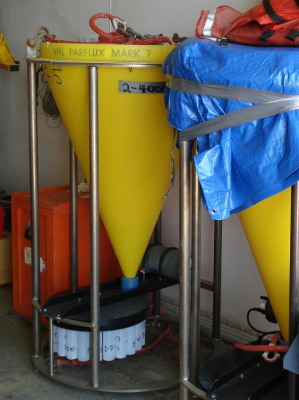|
Hawaii Ocean Time-series (HOT)
in the School of Ocean and Earth Science and Technology at the University of Hawai'i at Manoa |
|
| » Home » Analytical Results » Bottom-Moored Sediment Traps | |||||||||||||||||||||||||||||||||||||||||||||||||||||||||||||||||||||||||||||||||||||||||||||||||||||||||
Bottom-Moored Sediment Traps
Sampling ProcedureA bottom-moored sediment trap experiment has been in place since June 1992 at a site near Station ALOHA. Schedule of deployments and retrievals is shown in Table 1 below. The ALOHA-XXV mooring was deployed in January 2023. The present experiment consists of 2 Parflux MK7-21 sequencing sediment collectors located at 2800 m & 4000 m. A separate sampling cup will be rotated into the collector position on an approximately 10-20 day cycle, depending on the deployment period. Samples from each cup will initially be divided into four 60-ml volumes (also refered to as splits). Each split will further be divided into the volumes required for the various analysis.
Table 1: Schedule of Deployments and Recoveries of Moored Sediment Trap ResultsParticulate carbon flux measurements from the ALOHA-I and II sediment traps is shown in Figure 65. Particulate carbon, as well as particulate nitrogen, phosphorus and mass, showed a major export pulse during the summer periods when the upper water column was well stratified. A second export pulse was also observed in late winter-early spring but this feature appears to be different than the summer peak. The major particulate matter export was recorded in the same collector cups regardless of depth suggesting a sinking rate of about 200 m d-1. Analysis of chlorophyll a by fluorometry and HPLC pigment analyses reveal that the peak export event coincides with the removal of pigmented cells. The summer export material contains the full spectrum of major and accessory pigments. Microscopic analysis showed the dominance of diatoms during the summer export. A discussion of some of the findings has been presented in Karl et al. (1996a and 1997). | |||||||||||||||||||||||||||||||||||||||||||||||||||||||||||||||||||||||||||||||||||||||||||||||||||||||||

